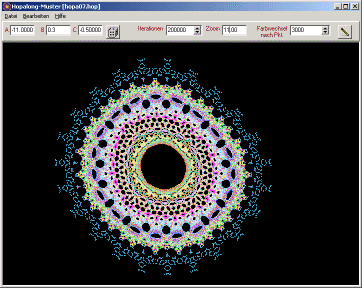Fractal Home
Iterations II - Hopalong
Here we have a look at the Martin-Attractors (don't miss page 2), also known as Hopalongs, a sort of orbit-fractals. They are images of a simple two-dimensional iteration system. The name Hopalong is derived from the fact, that such an image is built of points hopping along on an elliptical path starting from one point in the center. Hopalong orbits were discovered by Barry Martin from the Aston University, Birmingham, England. A.K. Dewdney presented the Hopalongs in the magazine "Scientific American" (1986) and in Germany they became famous because they have been mentioned in the magazine "Spektrum der Wissenschaft".
The algorithm
An image is calculated using three parameters a, b and c. Dewdney's article contains the following programme:
INPUT num
INPUT a, b, c
x = 0
y = 0
PLOT(x, y)
FOR i = 1 TO num
xx = y - SIGN(x) * [ABS(b*x - c)]^0.5
yy = a - x
x = xx
y = yy
ABS is the absolute value function. SIGN(x) is the same as x/ABS(x). If x>0 then SIGN(x) = 1, if x<0 then SIGN(x) = −1 and if x = 0 then the result of SIGN(x) is zero, too.
After a certain number of points the color is changed. Normally The image doesn't depend on the first point. These attractors have the butterfly effect. That means if you change the parameters a bit, you'll get a total new image with very little similarity to the first one.

Screenshot of the Hopalong Program
The program
A modern version of the program is available with the file hopalong1.zip. The data files for the gallery images are included.
Thanks
Parts of the Iterations sections were created in cooperation with Henning Kopp.








